Click on images to enlarge

infestation (Photo: Jan Samanek, State Phytosanitary Administration, Bugwood.org)
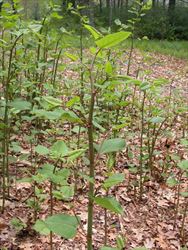
habit of young growth (Photo: Greg Jordan)

habit in flower (Photo: Jan Samanek, State Phytosanitary Administration, Bugwood.org)
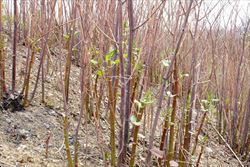
habit of old growth (Photo: Jan Samanek, State Phytosanitary Administration, Bugwood.org)
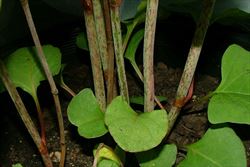
stems (Photo: Sheldon Navie)
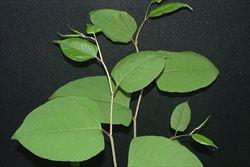
leaves (Photo: Sheldon Navie)
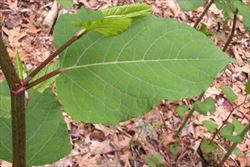
stem and leaves (Photo: Greg Jordan)
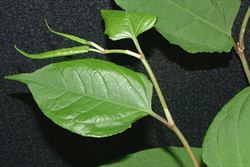
young leaves with ochreae (Photo: Sheldon Navie)

close-up of leaf (Photo: Sheldon Navie)
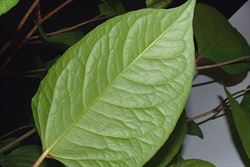
leaf underside (Photo: Sheldon Navie)
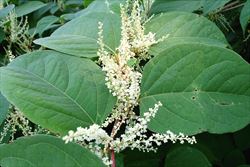
flower clusters (Photo: Jan Samanek, State Phytosanitary Administration, Bugwood.org)
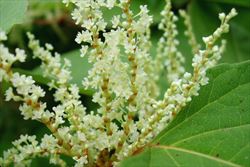
close-up of flowers (Photo: Jan Samanek, State Phytosanitary Administration, Bugwood.org)
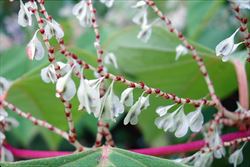
mature fruit (Photo: Jan Samanek, State Phytosanitary Administration, Bugwood.org)
Scientific Name
Fallopia japonica (Houtt.) Ronse Decr.
Synonyms
Fallopia japonica (Houtt.) Ronse Decr. var. compacta (Hook. f.) J.P. BaileyPolygonum cuspidatum Sieb. & Zucc.Reynoutria japonica Houtt.Tiniaria japonica (Houtt.) Hedberg
Family
Polygonaceae
Common Names
Asiatic knotweed, crimson beauty, donkey rhubarb, fallopia, fleece flower, gypsy rhubarb, Hancock's curse, Japanese bamboo, Japanese fleece flower, Japanese fleece-flower, Japanese fleeceflower, Japanese knotweed, Japanese polygonum, Mexican bamboo, Sally rhubarb, wild rhubarb
Origin
Native to eastern Asia (i.e. Japan, China, Korea, Vietnam and Taiwan).
Cultivation
This species was probably introduced as a garden ornamental. It has occasionally been grown for this purpose in the temperate regions of Australia.
Naturalised Distribution
Japanese knotweed (Fallopia japonica ) is not widely naturalised in Australia, currently being limited to a few isolated infestations in Victoria, eastern New South Wales and Tasmania.
However, it is widely naturalised in other parts of the world (i.e. in Europe, Asia, New Zealand, the USA and Canada).
Habitat
A potentially serious weed of waterways, wetlands, riparian areas, forest margins, roadsides, waste areas, disturbed sites and coastal environs in the temperate regions of Australia.
Habit
A large long-lived (i.e. perennial), herbaceous or shrubby, plant usually growing to 1.8 m tall, but occasionally reaching up to 3 m in height. The aboveground growth can be relatively short-lived, often dying back during winter and then re-growing again from its extensive network of long-lived creeping underground stems (i.e. rhizomes).
Distinguishing Features
- a large herbaceous or shrubby plant (up to 1.8 m or more tall) with a network of long-lived creeping underground stems.
- its shorter-lived upright stems are smooth, hollow, and have prominent joints that give them a slightly bamboo-like appearance.
- its slightly heart-shaped to somewhat triangular stalked leaves (5-15 cm long and 5-12 cm wide) are alternately arranged.
- where the leaf stalk meets the stem there is a membranous, sheath-like, structure.
- its small whitish or greenish flowers (about 2.5-3 mm across) are borne in large clusters (10-12.5 cm long), and male and female flowers are produced on separate plants.
- its dark brown or blackish seeds (2-4 mm long and about 2 mm wide) are enclosed in a three-winged fruit (6-10 mm long).
Stems and Leaves
The branching upright (i.e. erect) stems are smooth, hollow, and reddish or reddish-brown in colour. They are slightly ridged lengthwise (i.e. longitudinally) and have prominent joints (i.e. nodes) that give them a slightly bamboo-like appearance. These stems may become slightly woody (up to 4 cm thick) and generally turn paler brown in colour as they mature.
The alternately arranged leaves are either slightly heart-shaped (i.e. sub-cordate), egg-shaped in outline (i.e. ovate) or somewhat triangular in shape. These moderately large leaves (5-15 cm long and 5-12 cm wide) are hairless (i.e. glabrous) and borne on ridged stalks (i.e. petioles) 10-30 mm long. Where the leaf stalk meets the stem there is a small, membranous, sheath-like structure (i.e. an ochrea). The leaf blades have dark green upper surfaces and paler green undersides and their veins are often reddish in colour. Their margins are entire and they have pointed tips (i.e. acute or shortly acuminate apices).
Flowers and Fruit
This species has separate male and female flowers on separate plants (i.e. it is dioecious). The flowers are small (about 2.5-3 mm across) and whitish, cream or greenish in colour. They are borne in dense elongated, and often branched, clusters (3-12.5 cm long) that are produced in the upper leaf forks (i.e. axils). The male flower clusters are generally borne in an upright position, while the female flower clusters often have a drooping appearance. The individual flowers have five 'petals' (actually perianth segments or tepals) that are 2-8 mm long and are borne on stalks (i.e. pedicels) 3-4 mm long. The male flowers also have eight stamens, while the female flowers have three styles topped with feathery (i.e. fimbriate) stigmas. As the female flowers mature, three of the 'petals' become enlarged, fuse together, and develop a wing on their outer surfaces. Flowering mostly occurs during late summer.
The fruit, which is only produced on female plants, consists of a small dark brown or blackish coloured 'seed' (i.e. achene) enclosed in a three-winged structure (i.e. the remains of the three outer 'petals') that is 6-10 mm long. The seeds (2-4.5 mm long and about 2 mm wide) are somewhat triangular in shape (i.e. trigonous) and shiny in appearance.
Reproduction and Dispersal
This species reproduces by seeds and also by shoots from its creeping underground stems (i.e. rhizomes).
The thick underground stems (i.e. rhizomes) may spread considerable distances from the parent plant (up to 20 m) and are usually the main form of spread, as seeds are not often produced outside its native range. Both seeds and rhizome fragments may be dispersed by water, machinery, in soil, or in dumped garden waste. The papery mature fruit may also be spread by wind movement.
Environmental Impact
Japanese knotweed (Fallopia japonica) is regarded as a potentially serious environmental weed in Victoria and Tasmania, and as a "sleeper weed" in other parts of southern Australia. It was recently found to be naturalised for the first time in Victoria, in the Great Dividing Range north of Healesville, and is also known to occur in northern Tasmania (i.e. in the Dorset, Launceston and West Tamar regions). In New South Wales it has occasionally been recorded as naturalised in the Central Coast and Southern Tablelands districts.
This species is already a significant environmental weed and in many temperate regions of the world. Japanese knotweed (Fallopia japonica) is very aggressive and can rapidly displace native vegetation, particularly in riparian habitats, through shading and root competition. Its long-lived underground stems (i.e. rhizomes) are able to penetrate to significant depths and can regrow from small pieces, making established infestations extremely persistent and difficult to remove. These spreading rhizomes usually provide this species with a competitive over less vigorous native plants. It also forms dense thickets of aboveground vegetation which shade out other species and prevent their regeneration, reducing the biodiversity of invaded areas and altering the habitat available to native animals. For example, in other parts of the world, this species is known to have a significant negative impact on the diversity of plant-eating insects.
Japanese knotweed (Fallopia japonica) is officially regarded as the most pernicious weed in the UK, where vast amounts of money are spent on its management. It is such a problem in other parts of the world, particularly in Europe and North America, that it has been listed in the Global Invasive Species Database as one of the top 100 of the world's worst invasive alien species.
Other Impacts
Japanese knotweed (Fallopia japonica) can cause blockages in waterways, as the dead stems accumulate in rivers and streams channels, increasing the risk of flooding. It can also contribute to the erosion of riverbanks, restrict access to waterways, and interfere with irrigation channels in cropping areas. The underground stems, and emerging shoots, can also cause damage to paving, bitumin roadways and other structures.
Legislation
This species is declared under legislation in the following states and territories:
- Tasmania: D - the importation or sale of this species is prohibited and measures to reduce its population in an area, eradicate it from an area, or restrict it to a particular area may be required.
- Victoria: S - prohibited and to be eradicated from the state if possible.
- Western Australia: Prohibited - on the prohibited species list and not permitted entry into the state.
Management
For information on the management of this species see the following resources:
- the Victorian Department of Primary Industries Landcare Note on this species, which is available online at http://www.dpi.vic.gov.au.
Similar Species
Japanese knotweed (Fallopia japonica) is very similar to giant knotweed (Fallopia sachalinensis) and Bohemian knotweed (Fallopia x bohemica), a hybrid between these two species. These plants can be distinguished by the following differences:
- Japanese knotweed (Fallopia japonica ) is a relatively large plant (up to 3 m tall) with moderately-sized leaves (5-15 cm long and 5-12 cm wide) that are broadly egg-shaped in outline (i.e. ovate), somewhat triangular, or slightly heart-shaped (i.e. sub-cordate). The leaf bases are usually flattened or squared-off (i.e. truncate) in appearance (occasionally they are very slightly lobed) and the leaves are hairless (i.e. glabrous). The flowers are have relatively small 'petals' (i.e. perianth segments) 2-8 mm long and the mature seeds are enclosed in a relatively small narrowly three-winged fruit (6-10 mm long).
- giant knotweed (Fallopia sachalinensis) is a very large plant (up to 5 m tall) with very large leaves (15-40 cm long and about 20 cm wide) that are strongly heart-shaped (i.e. cordate) in outline. Its leaf bases are deeply lobed and the leaves are mostly hairless (i.e. glabrous), except for a few hairs on their undersides. The flowers have relatively large 'petals' (i.e. perianth segments) 6-15 mm long and the mature seeds are enclosed in a relatively large broadly three-winged fruit (12-15 mm long).
- Bohemian knotweed (Fallopia x bohemica) has an appearance that fits somewhere between the above two species and is difficult to distinguish from them, however it is generally more similar to Japanese knotweed (Fallopia japonica). It is a large plant (up to 4 m tall) with moderately large leaves (up to 20 cm long and nearly as broad) that are broadly egg-shaped in outline (i.e. ovate), somewhat triangular in shape, or heart-shaped (i.e. cordate). The bases of these leaves are usually slightly lobed or rounded.
Japanese knotweed (Fallopia japonica) is also relatively similar to some of the larger smartweeds (i.e. Persicaria spp.), such as prince's feather (Persicaria orientalis), white smartweed (Persicaria attenuata) and pale smartweed (Persicaria lapathifolia). However, the smartweeds (Persicaria spp.) do not have separate male and female flowers on different plants, and their fruit are not distinctively winged. Prince's feather (Persicaria orientalis) can also be distinguished by it densely hairy (i.e. pubescent) leaf surfaces and pale pink flowers. White smartweed (Persicaria attenuata) has somewhat hairy (i.e. pubescent) elongated leaves (8-26 cm long and 1-5 cm wide), while pale smartweed (Persicaria lapathifolia) has elongated leaves (6-23 cm long and 1-3.5 cm wide) and pale pink flowers.

